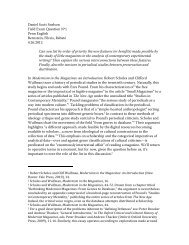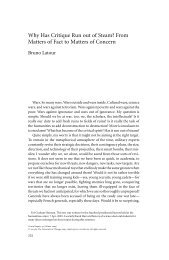The Exploit: A Theory of Networks - asounder
The Exploit: A Theory of Networks - asounder
The Exploit: A Theory of Networks - asounder
You also want an ePaper? Increase the reach of your titles
YUMPU automatically turns print PDFs into web optimized ePapers that Google loves.
88 Nodes<br />
argues that there cannot be A and not - A at the same time (e.g., if an<br />
archer shoots an arrow and measures its distance to a tree by dividing<br />
the distance in half each time, the arrow never reaches the tree. But<br />
how can the arrow both reach the tree and not reach the tree?). <strong>The</strong>re<br />
must be a unity, a One - All behind everything that changes. In a sense,<br />
our inability to totally classify biological or computer viruses serves as<br />
a counterpoint to this earlier debate. If viruses are in fact defined by<br />
their ability to replicate their difference, we may ask, what is it that<br />
remains identical throughout all the changes? One reply is that it is<br />
the particular structure <strong>of</strong> change that remains the same—permutations<br />
<strong>of</strong> genetic code or computer code. <strong>The</strong>re is a becoming - number<br />
specific to viruses, be they biological or computational, a mathematics<br />
<strong>of</strong> combinatorics in which transformation itself—via ever new<br />
exploitation <strong>of</strong> network opportunities—is the identity <strong>of</strong> the virus.<br />
If the computer virus is a technological phenomenon cloaked in the<br />
metaphor <strong>of</strong> biology, emerging infectious diseases are a biological phenomenon<br />
cloaked in the technological paradigm. As with computer viruses,<br />
emerging infectious diseases constitute an example <strong>of</strong> a counterprotocol<br />
phenomenon.<br />
In this way, epidemiology has become an appropriate method for<br />
studying computer viruses. Emerging infectious diseases depend on,<br />
and make use <strong>of</strong>, the same topological properties that constitute networks.<br />
<strong>The</strong> same thing that gives a network its distributed character,<br />
its horizontality, is therefore transformed into a tool for the destruction<br />
<strong>of</strong> the network.<br />
An example is the 2003 identification <strong>of</strong> SARS (severe acute respiratory<br />
syndrome). While there are many, many other diseases that<br />
are more crucial to look at from a purely public health perspective,<br />
we find SARS interesting as a case study for what it tells us about the<br />
unhuman, viral perspective <strong>of</strong> networks.<br />
<strong>The</strong> SARS case is noteworthy for the rapidity with which the<br />
virus was identified. <strong>The</strong> World Health Organization estimates that<br />
it took a mere seven weeks to identify the virus responsible for SARS<br />
(and a mere six days to sequence the virus genome). 65 Compared to<br />
the three years it took to identify HIV, and the seven years it took to









